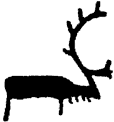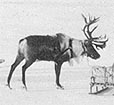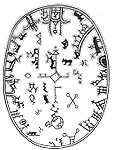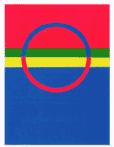
|
|
|
|
Báiki (ba-hee-kee) n. 1. Reindeer herding term for group survival and cultural identity as people migrate from place to place - "the home that lives in the heart." 2. The North American Sami Journal containing articles in English on the Sami culture by Sami and Native American authors. Contact Báiki, 1430 32nd St. #2, Oakland, CA 94608; (510) 547-0350. Drum n. A sacred map made of reindeer skin and birch, painted with alder juice drawings of people and the Spirits of Nature and the Four Directions often centered around a symbol of the Sun. Used traditionally by Sami families to guide their daily life, foresee the future, locate things which are missing and heal diseases. (Note: It should never be called "a magic drum," which would be the equivalent of calling a crucifix "a magic cross.") duodji (dwoi-djee) n. 1. Sami handcrafts made from reindeer parts, birch, silver, brass, pewter and woven cloth. 2. Ordinary useful objects beautified with Sami designs. Finn n. Old Norse word for Sami people. flag n. Adopted in 1989, the Sami flag stands for Nature. The red is for the Sun, the blue for the Moon, the yellow and green for Nature's colors and the circles for the cycles of Nature. food n. The Sami diet is simple and healthy. It consists of fish caught in lakes, rivers and the ocean, reindeer meat that is dried in the sun, smoked, or cooked in a stew with potatoes, and cloudberries and mushrooms gathered from the forests and bogs. Shredded carrots, sliced peppers amd bok choy often accompany a Sami meal as do bread, cheese and coffee.
|
|
|
gakti (gahk-tee) n. Sami traditional clothing based on the primary colors of Nature and decorated with symbols of one's family origin. Gakti is work clothing for some reindeer herders and older traditional people and is commonly worn during festive occasions and at Indigenous conferences by Sami cultural activists. (Note: gakti is not called a "costume.") gietka (gyet-kah) n. Sami cradleboard similar to Native American cradleboards. goahtti (go-wah-tee) n. A round hut made from canvas or earth stabilized with two inner arches. indigenous adj. 1. The aboriginal inhabitants of an area. 2. The descendants of the original inhabitants of an area who have been colonized. The Sami are indigenous to Scandinavia, Finland and the Russian Kola Peninsula. (Note: When used to refer to a People, "Indigenous" is capitalized.) joik (yoik) n. Sami vocable throat singing or chanting of sacred origin now used in rock and jazz as well as traditional expressions. v. To honor or commit to memory a person, an event, or a part of Nature by chanting. Lapp n., Lappish adj. Derogatory and archaic term for Sami people and Sami subjects said to mean "outcast." lavvu (lahv-oo) n. Circular Sami tent centered with a fire pit similar to a Native American tepee. The spiritual center of the Sami universe and family. Nature religion The Sami belief that all life is dualistic on both spiritual and physical levels and that people must live in harmony without disturbing Nature. noiade (noy-deh) n. A person recognized by the community as one who can communicate with the Spirits to heal the sick and find lost articles. Similar in cultural responsibility to a Native American Medicine Man or Woman.
|
 reindeer petroglyph |
The Pathfinder A film directed by Nils Gaup based on a 1000-year-old Sami legend about the ageless conflict between Indigenous People (in this case the Sami) and their oppressors (who take many forms). Received the Academy Award nomination for Best Foreign Film of 1989 and is available through video stores. Don't miss it! petroglyph (peh-tro-glif) n. An ancient rock carving or line drawing found throughout Sápmi. pictograph (pick-toe-graf) n. 1. A picture or symbol representing a word or idea. 2. A line drawing on a Sami Drum. Population demographics There are about 60,000 Sami people in Sápmi: 35,000 in Norway, 17,000 in Sweden, 5,000 in Finland and 3,000 on the Russian Kola Peninsula. It is estimated that there are now also 30,000 descendants of the Sami immigrants to North America who usually hid their identity and settled in areas where Scandinavians and Finnish people settled. They sometimes referred to themselves as Black Norwegians, Brown Swedes, Flat-faced Norwegians, and Finns.
|
 reindeer |
reindeer n. A large Arctic deer, Rangifer tarandus, having branched antlers in both sexes, and capable of being domesticated unlike its wild caribou cousin. Reindeer provide meat, tools and clothing for the Sami. Today only 10% of Sami people can make their living herding reindeer. Sami (sah-mee) also spelled SÁÁMI, SÁMI, and SAMEH. 1. The Indigenous people of Norway, Sweden , Finland and the Russian Kola Peninsula. 2. "The People of the Sun." Sámigiella (sah-mee-gyell-ah) n. The Sami language, part of the Finno-Ugric group along with Finnish, Estonian and Hungarian. There are nine different language areas. Today Northern Sámigiella is the most widely spoken. Sápmi (sahp-mee) n. 1. The circumpolar area where Sami people live and where the Sami language is spoken. 2. The land of Sami people without borders. Siedde (see-eh-deh) n. A sacred rock that helps the People and Nature survive through prayer and offerings. siidda (se-dah) n. The Sami extended family system of exchanging and sharing goods and services within a particular geographic area. A siidda usually consists of about 50 people. Sun 1. The central star of the solar system. 2. The center of the Sami Naiure Religion. 3. The Giver of Life and the origin of the Sami people who call themselves "The People of the Sun." |
![]()
Copyright
©
2001
BÁIKI:
the North American Sami Journal
All rights reserved



